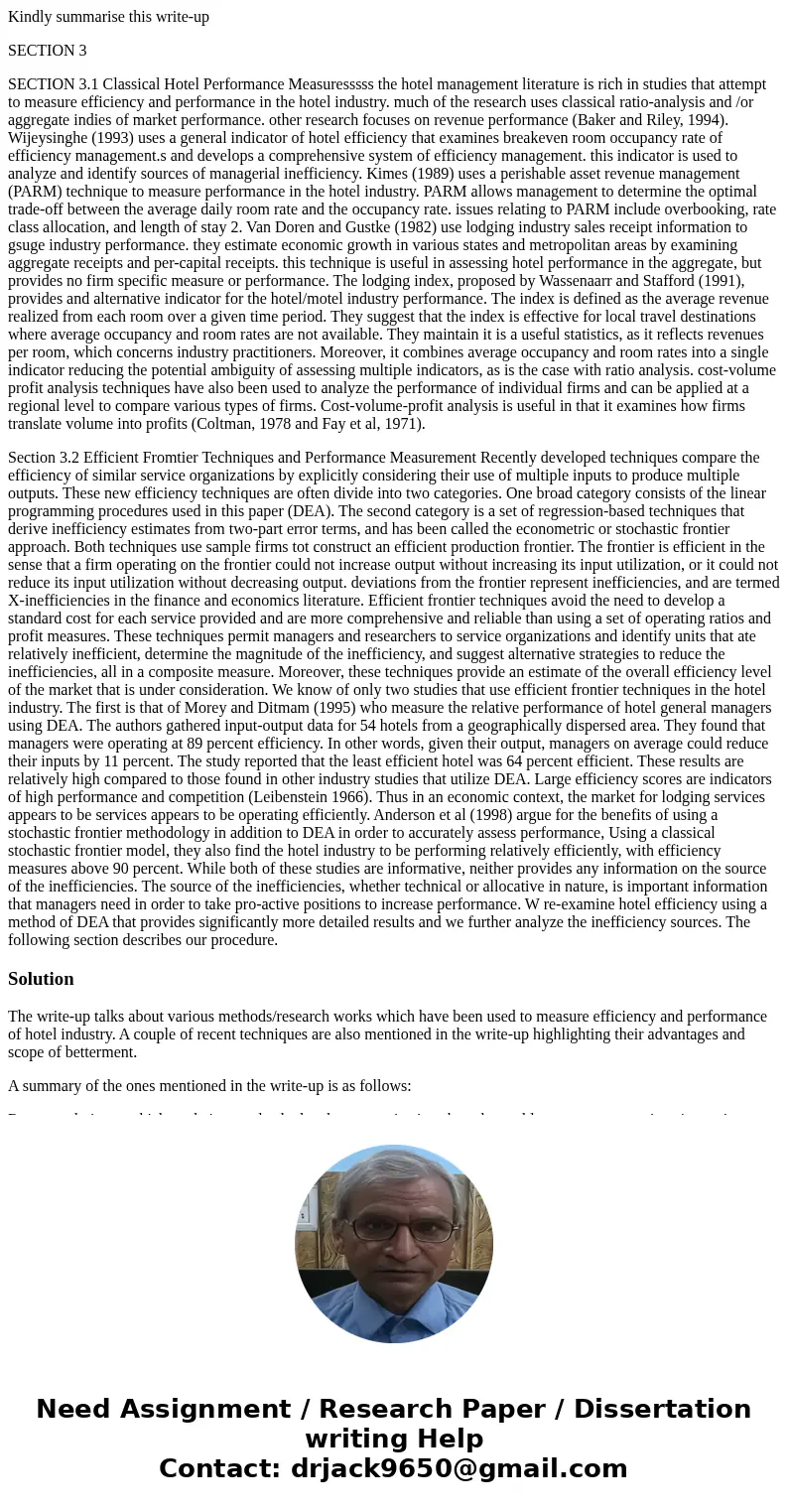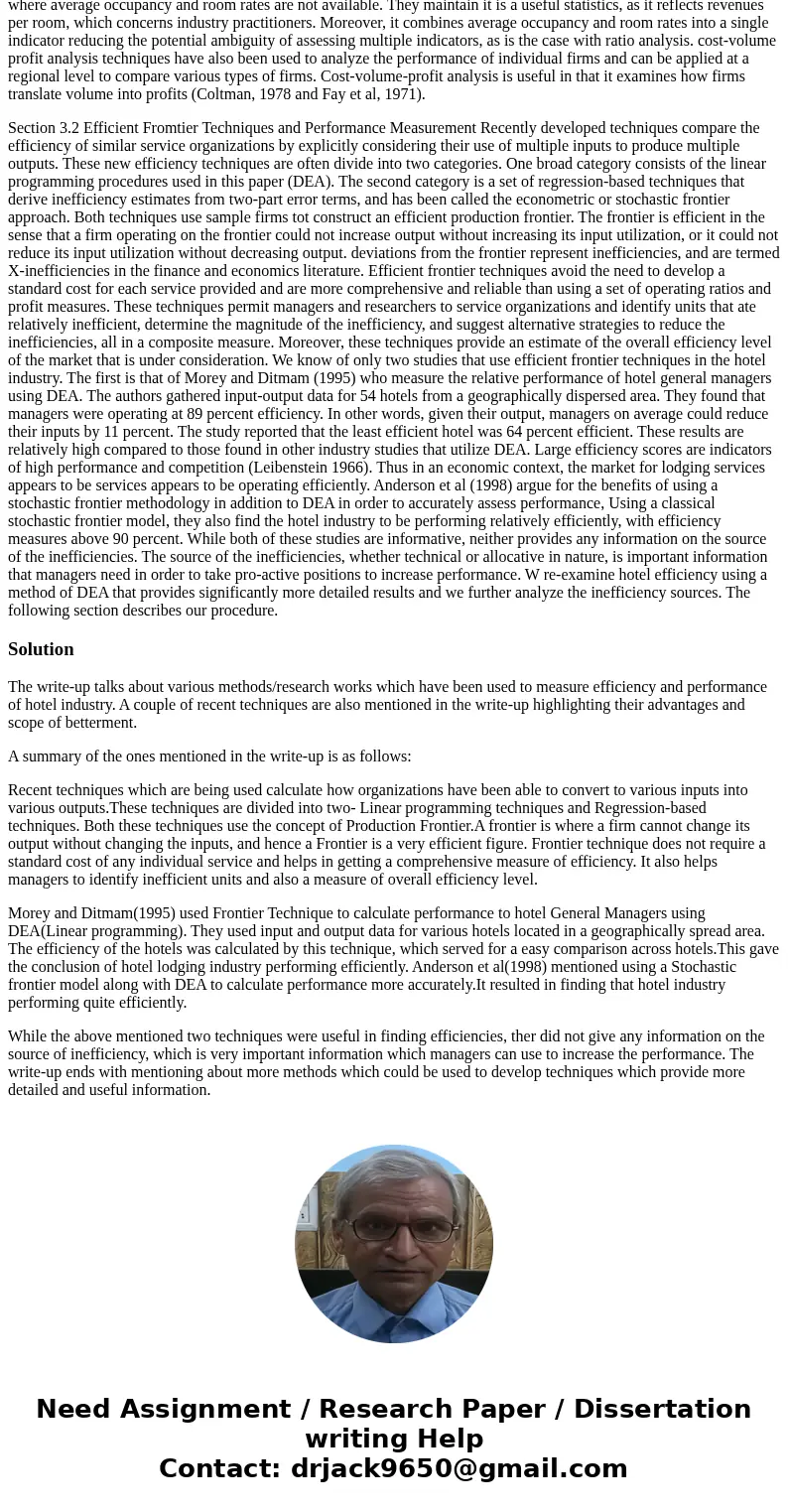Kindly summarise this writeup SECTION 3 SECTION 31 Classical
Kindly summarise this write-up
SECTION 3
SECTION 3.1 Classical Hotel Performance Measuresssss the hotel management literature is rich in studies that attempt to measure efficiency and performance in the hotel industry. much of the research uses classical ratio-analysis and /or aggregate indies of market performance. other research focuses on revenue performance (Baker and Riley, 1994). Wijeysinghe (1993) uses a general indicator of hotel efficiency that examines breakeven room occupancy rate of efficiency management.s and develops a comprehensive system of efficiency management. this indicator is used to analyze and identify sources of managerial inefficiency. Kimes (1989) uses a perishable asset revenue management (PARM) technique to measure performance in the hotel industry. PARM allows management to determine the optimal trade-off between the average daily room rate and the occupancy rate. issues relating to PARM include overbooking, rate class allocation, and length of stay 2. Van Doren and Gustke (1982) use lodging industry sales receipt information to gsuge industry performance. they estimate economic growth in various states and metropolitan areas by examining aggregate receipts and per-capital receipts. this technique is useful in assessing hotel performance in the aggregate, but provides no firm specific measure or performance. The lodging index, proposed by Wassenaarr and Stafford (1991), provides and alternative indicator for the hotel/motel industry performance. The index is defined as the average revenue realized from each room over a given time period. They suggest that the index is effective for local travel destinations where average occupancy and room rates are not available. They maintain it is a useful statistics, as it reflects revenues per room, which concerns industry practitioners. Moreover, it combines average occupancy and room rates into a single indicator reducing the potential ambiguity of assessing multiple indicators, as is the case with ratio analysis. cost-volume profit analysis techniques have also been used to analyze the performance of individual firms and can be applied at a regional level to compare various types of firms. Cost-volume-profit analysis is useful in that it examines how firms translate volume into profits (Coltman, 1978 and Fay et al, 1971).
Section 3.2 Efficient Fromtier Techniques and Performance Measurement Recently developed techniques compare the efficiency of similar service organizations by explicitly considering their use of multiple inputs to produce multiple outputs. These new efficiency techniques are often divide into two categories. One broad category consists of the linear programming procedures used in this paper (DEA). The second category is a set of regression-based techniques that derive inefficiency estimates from two-part error terms, and has been called the econometric or stochastic frontier approach. Both techniques use sample firms tot construct an efficient production frontier. The frontier is efficient in the sense that a firm operating on the frontier could not increase output without increasing its input utilization, or it could not reduce its input utilization without decreasing output. deviations from the frontier represent inefficiencies, and are termed X-inefficiencies in the finance and economics literature. Efficient frontier techniques avoid the need to develop a standard cost for each service provided and are more comprehensive and reliable than using a set of operating ratios and profit measures. These techniques permit managers and researchers to service organizations and identify units that ate relatively inefficient, determine the magnitude of the inefficiency, and suggest alternative strategies to reduce the inefficiencies, all in a composite measure. Moreover, these techniques provide an estimate of the overall efficiency level of the market that is under consideration. We know of only two studies that use efficient frontier techniques in the hotel industry. The first is that of Morey and Ditmam (1995) who measure the relative performance of hotel general managers using DEA. The authors gathered input-output data for 54 hotels from a geographically dispersed area. They found that managers were operating at 89 percent efficiency. In other words, given their output, managers on average could reduce their inputs by 11 percent. The study reported that the least efficient hotel was 64 percent efficient. These results are relatively high compared to those found in other industry studies that utilize DEA. Large efficiency scores are indicators of high performance and competition (Leibenstein 1966). Thus in an economic context, the market for lodging services appears to be services appears to be operating efficiently. Anderson et al (1998) argue for the benefits of using a stochastic frontier methodology in addition to DEA in order to accurately assess performance, Using a classical stochastic frontier model, they also find the hotel industry to be performing relatively efficiently, with efficiency measures above 90 percent. While both of these studies are informative, neither provides any information on the source of the inefficiencies. The source of the inefficiencies, whether technical or allocative in nature, is important information that managers need in order to take pro-active positions to increase performance. W re-examine hotel efficiency using a method of DEA that provides significantly more detailed results and we further analyze the inefficiency sources. The following section describes our procedure.
Solution
The write-up talks about various methods/research works which have been used to measure efficiency and performance of hotel industry. A couple of recent techniques are also mentioned in the write-up highlighting their advantages and scope of betterment.
A summary of the ones mentioned in the write-up is as follows:
Recent techniques which are being used calculate how organizations have been able to convert to various inputs into various outputs.These techniques are divided into two- Linear programming techniques and Regression-based techniques. Both these techniques use the concept of Production Frontier.A frontier is where a firm cannot change its output without changing the inputs, and hence a Frontier is a very efficient figure. Frontier technique does not require a standard cost of any individual service and helps in getting a comprehensive measure of efficiency. It also helps managers to identify inefficient units and also a measure of overall efficiency level.
Morey and Ditmam(1995) used Frontier Technique to calculate performance to hotel General Managers using DEA(Linear programming). They used input and output data for various hotels located in a geographically spread area. The efficiency of the hotels was calculated by this technique, which served for a easy comparison across hotels.This gave the conclusion of hotel lodging industry performing efficiently. Anderson et al(1998) mentioned using a Stochastic frontier model along with DEA to calculate performance more accurately.It resulted in finding that hotel industry performing quite efficiently.
While the above mentioned two techniques were useful in finding efficiencies, ther did not give any information on the source of inefficiency, which is very important information which managers can use to increase the performance. The write-up ends with mentioning about more methods which could be used to develop techniques which provide more detailed and useful information.


 Homework Sourse
Homework Sourse